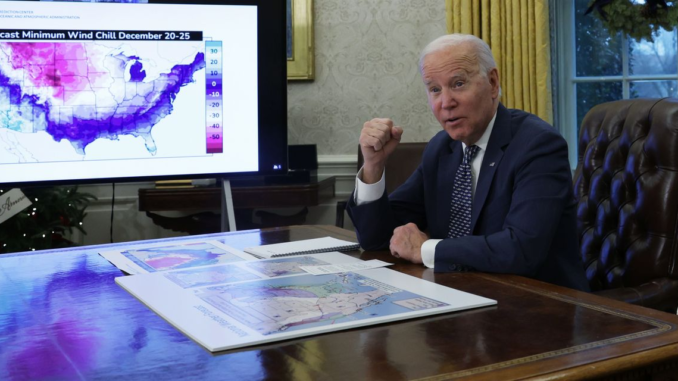
ENB Pub Note: The Omnibus bill at $1.7 trillion has less than $35 million set aside for the national grid. And even closer to $16 million for specific grid updates. Physics does not lie, and the renewable energy plan will not work on the existing grid. The costs to consumers will be felt through inflation and even higher energy costs.
Damaging winds have knocked out power to over 1.5 million customers stretching from Texas to New England, according to the site PowerOutage.US.
Among the largest clusters of powerless businesses and homes, over 150,000 customers were without lights and potentially, heat, in North Carolina and over 102,000 were without power in much-colder Connecticut, the site said.
Severe weather can bring havoc to even the sturdiest portions of the power grid, but there’s no doubt that each winter (and in summer’s extremes), the country braces for the worst given the age and general vulnerability of the electricity grid for the globe’s largest economy.
In its annual report, the U.S. electric grid was given a C- grade by the American Society of Civil Engineers.
Separately, the U.S. Department of Energy found that 70% of U.S. transmission lines are more than 25 years old in the agency’s most recent network-infrastructure review, held back in 2015. Lines typically have a 50-year lifespan. The average age of large power transformers, which handle 90% of U.S. electricity flow, is more than 40 years, the agency found.
Some estimates put the price tag on an electricity grid overhaul at upwards of $2 trillion, according to SwissRe. And agreeing on repairs is complicated by the web of state, regional and federal regulatory hurdles to consider.
For now, it could be days for power to return to trouble spots in the country and conditions for outdoor workers are extremely dangerous. More than 200 million people in the U.S. are under wind chill alerts from the Canadian border to the Mexican border and from Washington state to Florida, with below-zero wind chills expected in the Southeast by Friday.
Read: Five tips for staying safe and warm during a power outage
Other winter weather alerts are in effect for blizzard conditions, ice, snow, and even flooding. In response to the late-week storm, more than a dozen governors have launched emergency-response plans.
“The National Weather Service’s Watch Warning graphic depicts one of the greatest extents of winter weather warnings and advisories ever,” the agency said.
Read: Six survival tips for traveling by car during a blizzard
Spending on the grid
The government has made upgrading the power grid a priority but any response still won’t be in time for this storm, and it bears down with the deadly Texas power outage of 2021 still top of mind.
That year, record-breaking snowstorms knocked out power for nearly 4.5 million homes in Texas as icy conditions and home-heating demands overwhelmed much of the state’s power supply, which is fed by a combination of natural gas NG00, +2.52% and wind power WNDY, +0.03%. Texas is equipped to ramp up its power when high air-conditioning use kicks in, but a winter storm, and its impact on broken gauges from the energy sources feeding the utilities, was not in the playbook.
More than 100 people died, and the storms caused an estimated $295 billion in damage for a unique state-run power grid, known as ERCOT. The rest of the country tends to run on regional power, under more uniform regulations.
The Texas calamity raised fresh questions for the future of renewable energy in the large-and-growing state and elsewhere, aided by images of ice-caked wind turbines. But to blame renewables at a time when they need more, not less, of the nation’s power system to modernize is short-sighted, especially as more extreme weather due to climate change is likely, said energy analysts.
For starters, the blame for the Texas power crunch, at least according to early readouts from Texas utilities officials, and backed by analysts, was multifold. That fact alone should energize the pursuit of a diverse energy portfolio and upgraded grid to help the U.S. rein in emissions contributing to global warming and keep energy relatively low cost, especially for vulnerable communities.
“The dangerous situations in Texas and Oklahoma underscore the urgency of the climate crisis and the need to make transformational investments in our country’s infrastructure, including the electricity grid,” said Lori Lodes, executive director of Climate Power, at the time of the Texas outage.
As for this week’s Texas storm, there haven’t been any widespread outages, but power demand has been higher than expected. ERCOT’s live dashboard shows the supply is still well ahead of the demand, with several thousand megawatts of reserves.
Still, the state’s power challenges extending to new seasons was a wake-up call for an entire nation seeing more weather extremes tied to climate change.
In response, last year’s $1.2 trillion bipartisan infrastructure bill included $65 billion for upgrading the U.S. electric grid.
“This is a long overdue investment,” said the Alliance to Save Energy (ASE), in a commentary. “The grid, which consists of more than 7,300 power plants, 160,000 miles of high-voltage power lines, and millions of low-voltage power lines, has parts that are more than a century old.”
Within the law, $65 billion will go toward investments in enhancing grid reliability and resilience, expanding and upgrading transmission lines, improving grid flexibility with demand response and distributed energy resources, and boosting cybersecurity and other defenses against sabotage.
“For American households, these investments should translate into fewer and shorter blackouts, cheaper energy costs and a cleaner environment,” the ASE said.
Efficiency really makes a difference
A recent report from a trio of energy groups showed that progress toward energy efficiency, and the need for even more, has been a key step in reducing the burden on the U.S. grid.
The 2023 Energy Efficiency Impact Report, released by the Alliance to Save Energy, American Council for an Energy-Efficient Economy (ACEEE), and the Business Council for Sustainable Energy (BCSE) says efficiency investments since 1980 have reduced annual energy expenditures in the U.S. by nearly $800 billion and have driven down energy consumption per household by 16%.
By prioritizing energy efficiency investments through implementation of recently passed federal legislation like the Inflation Reduction Act, states and federal agencies can cut energy costs for American families, improve energy resilience and reduce carbon emissions, the groups said.
The groups in particular called out vehicle fuel economy standards, appliance and equipment efficiency standards, utility sector energy efficiency programs, ENERGY STAR rebates for households that promote newer, smarter appliances, building energy codes, and federal research, development, and deployment, which they say reduced total U.S. energy consumption by roughly 29 quads in 2021, equal to roughly 30% of total U.S. energy consumption in that same year, or the energy use of the entire transportation sector.
Read: USPS will electrify entire mail-delivery fleet within just a few years
“As American families face winter storms and rising home energy costs, energy efficiency is a critical resilience solution that reduces the potential of blackouts and improves energy security,” said BCSE President Lisa Jacobson. “This report reveals that investments in energy efficiency leads to real and cost-effective improvements for energy reliability, emissions reductions and affordability. Prioritizing energy efficiency is central to advancing the energy transition in America and meeting our climate goals.”
The report outlines specific opportunities to further cost savings and emissions reduction through energy efficiency, such as adopting stronger energy codes for new buildings and building performance standards for existing ones; further adoption of industrial efficiency measures that can continue to drive down costs for firms and residential efficiency programs can increase the comfort and affordability of homes.
Rebuilding the grid for today and tomorrow
The advent of more electric-powered vehicles and appliances also means there will likely be a period of growing pains as surging demand for electricity outgrows the system’s upgrades.
Independent estimates indicate that the U.S. needs to expand electricity transmission systems by 60% by 2030, and may need to triple it by 2050 to meet the country’s increase in renewable generation and expanding electrification needs, the Department of Energy said.
Increasingly important are flexible use during peak and slower grid-use times, plus improvements for power storage. Advocates for greater EV adoption and swapping, for instance, gas-powered cook stoves and furnaces for electric options, realize any consumer-level “green” push will only be truly climate-friendly if the electricity grid gets “greener” at the same time, and can handle these new strains.
According to Charles Kutscher and Jeffrey Logan, both of the Renewable & Sustainable Energy Institute at the University of Colorado Boulder, there are basically three ways to accommodate the variability of wind and solar energy when used for the power grid: storage, such as with lithium batteries; deploying power generation in a coordinated fashion across a wide area of the country along with more transmission; and managing electricity demand to better match the supply.
What’s more, making the U.S. system work better as a whole is a big deal.
Transmission studies have shown that stronger interconnection among the country’s three primary power grids (there are seven grids in total) will be highly beneficial, as will making all our buildings, which use 74% of U.S. electricity, way more efficient.
Related: Severe heat: 5 electricity blackout risks facing the entire U.S., not just Texas
And then there’s storage, usually obtained with batteries. Right now, the U.S. largely depends on the fuel source, the coal, the natural gas, the sun, to generate power for electricity on demand.
It’s not only inefficient, it may no longer be possible due to winter and summer extremes with climate change.
“There is essentially no storage of electricity on the grid; instead most energy is stored in fuels – coal, natural gas, nuclear products and water behind dams, waiting for the command to be converted to electricity in real time,” said Joshua Rhodes, an energy research scientist at the University of Texas, Austin.
The oldest generators are large power plants, with many located in the eastern part of the U.S. But recent additions have been smaller and more spread out, in fact, as small as an individual’s rooftop solar panels.
“Some experts have even said that this model of more distributed generation closer to where power is consumed — along the edge of the network, rather than central power plants — is the new norm,” said Rhodes.
“Going forward, we can either build the grid back the same way we’ve done before or we can invest in new technologies that can bring the same service but at a lower cost,” he said.



